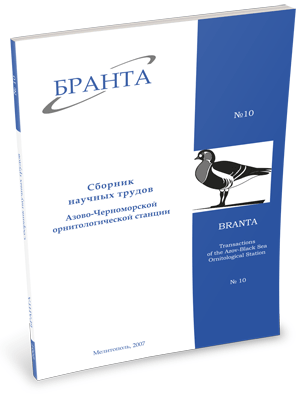
Transactions
of the Azov-Black Sea Ornithological Station



Individual, inter-seasonal and geographical variability of egg coloration in the Common Crane. Suggestion of a new method. Communication 1. Proposition of a new method. Individual variability in egg coloratio
S.V. Winter
In a long-term study (1989-2002) of the Common Crane (Grus grus) biology on three study areas in Eastern Ukraine a new method of describing the colouration and the micro-relief of the egg-shell surface was developed, following Kostin (1977). A total of 319 eggs in 171 clutches of free-living birds was studied. This is the largest sample so far.
Up to 107 characters of each egg were documented and frequencies compared between studies and years.
As a result three types of characters could be discriminated: (1) characters that change during the incubation process, (2) characters staying constant throughout the incubation process, (3) characters of the individual female, or of the population (rare characters, constant as well as changing, “markers”).
Among characters changing during incubation, the lime film on the egg-shell is found in about 20% of eggs (12% of females), being a clearly inherited character. After the 6th day of incubation, the comparison of the oily gloss of the egg-shell surface allows to determine the sequence of egg laying.
The total area of the egg-shell surface covered by spots (i.e. the “pattern density”) probably is an adaptive character: in 95.6% of the Common Crane eggs 15-40%, and in 96.9% of the Sandhill Crane (Grus canadensis) 20-35% of the total surface area are covered with spots.
The comparison of the qualitative egg characters between early (1989-1995) and late (1997-2002) years of the study period in one study area is carried out as well as that between different areas (about 60 km distance apart) within the same years (1997-2001). Inter-seasonal egg differences in one study area (significant differences of 14% of the characters) may be connected with a change of breeding females. A comparison of samples from the study areas A2 and A3 shows that for 4 out of 8 character groups the identity index (I) was significantly different. The greatest differences are recorded in the colouration of the superficial spots and the deep spots. In this comparison a considerable part of rare characters is represented only in one of the samples.
Qualitative characters of Common Crane and Sandhill Crane eggs are compared, and groups of conservative (common and similar in different samples) and variable (rare and changing in different samples) characters are distinguished. The characters of pattern density and the concentration of spots on the eggs are very similar in both species. However, in each species the spots are situated on different egg-shell background and are very different by colouration and size.
In general, the description of egg-colouration should aim at a more detailed recording even of the qualitative characters of colouration (an “atomization”), rather than simplifying the description by reducing details to a rough scheme only (e.g. in the approach of Klimov 2003). Our approach shows that one should differentiate characters as much, as the visual powers of distinction allow. Thus the measuring precision can be considerably increased, although it does not reach the precision of traditional quantitative characters (e.g. egg sizes).
In combination with quantitative egg parameters, the suggested method of description of qualitative characters increases the possibilities to analyse individual, populational and geographic variability of eggs and allows to use these data in population biology and in the systematics and phylogeny of this and other groups of birds.
Read the paper in a PDF file